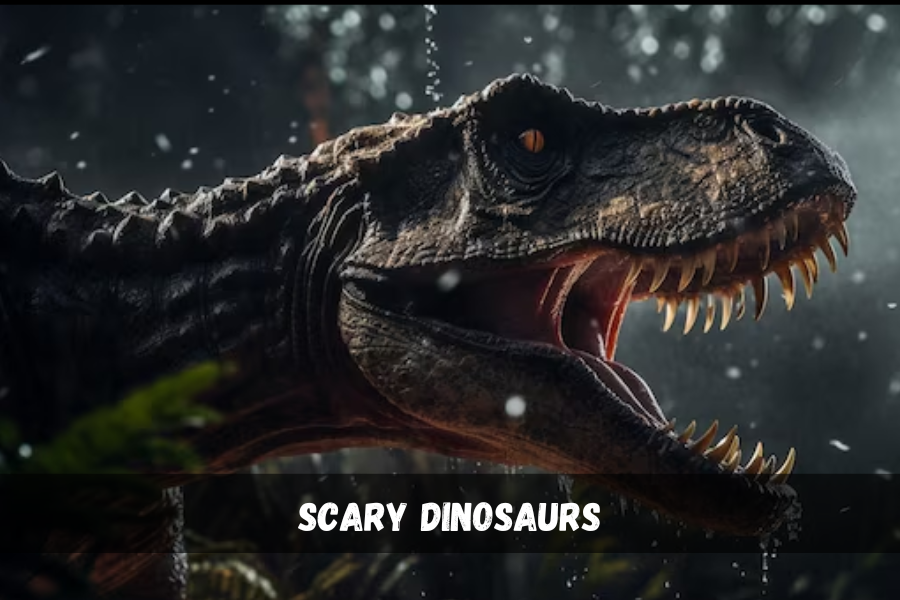Dinosaurs are some of the most fascinating creatures that ever roamed the Earth. While many dinosaurs were herbivores, feeding on plants, others were terrifying carnivores that dominated their environments. These scary dinosaurs, armed with powerful jaws, massive claws, and incredible speed, were apex predators in their time. This article delves into some of the most fearsome dinosaurs, offering insights into their terrifying features, behaviors, and roles in the prehistoric ecosystem.
1. Tyrannosaurus Rex: The Apex Predator
Arguably the most iconic of all dinosaurs, the Tyrannosaurus rex (T. rex) is often the first that comes to mind when people think of scary dinosaurs. The T. rex lived around 66 million years ago and was a fearsome predator in the Late Cretaceous period. Growing up to 40 feet in length and weighing as much as 10 tons, it was the largest land predator of its time. What made the T. rex so terrifying was its massive jaws and powerful bite. Its teeth were over 6 inches long and designed to crush bone and rip through flesh, making it a formidable hunter.
Despite its size, the T. rex was quite fast for its bulk, capable of running at speeds of around 20 to 25 miles per hour. This, combined with its excellent vision and keen sense of smell, allowed it to track down prey efficiently. Fossil evidence suggests that the T. rex may have been an opportunistic scavenger, as well as an active hunter. It likely targeted smaller dinosaurs, such as herbivores, but it could also overpower larger prey when the opportunity arose.
2. Spinosaurus: The Fearsome Fish Hunter
While the T. rex is often seen as the ultimate predator, the Spinosaurus might just give it a run for its money. This dinosaur, which lived around 112 million years ago during the Cretaceous period, was one of the largest carnivores to ever walk the Earth. Growing up to 50 feet long and weighing as much as 7-9 tons, Spinosaurus was not only a massive land predator, but it was also adapted to life in water. It is believed to have been semi-aquatic, hunting fish in rivers and lakes, using its long, crocodile-like snout to catch prey.
What made Spinosaurus even more terrifying was its unique sail-like structure on its back, formed by elongated neural spines. This sail could have been used for display, thermoregulation, or even to help with swimming. Spinosaurus had long, curved claws and powerful limbs that made it an expert in capturing fish, but it was also capable of taking down larger prey when necessary. This combination of aquatic and terrestrial hunting strategies made Spinosaurus a terrifying predator that ruled its ecosystem.
You Might Also Like: Are Jumping Spiders Friendly? A Comprehensive Guide
3. Velociraptor: The Fast and Cunning Hunter
The Velociraptor is another terrifying dinosaur, though not for its size. This small but deadly carnivore lived around 75 to 71 million years ago, during the Late Cretaceous period. Growing up to 6.5 feet long and weighing around 15-30 kilograms, Velociraptor was relatively small compared to some other predators, but its agility, intelligence, and hunting strategy made it one of the most efficient and fearsome predators of its time.
Velociraptor had a sickle-shaped claw on each of its feet, which it likely used to slash at prey, causing severe damage. This claw, combined with sharp teeth and a highly coordinated hunting strategy, made the Velociraptor a formidable predator. Many paleontologists believe that Velociraptors hunted in packs, which would have made them even more dangerous. In fact, the depiction of these dinosaurs in the Jurassic Park films, where they are shown as pack hunters, is thought to be based on scientific research.
4. Giganotosaurus: A Monster on the Prowl
While the T. rex is often considered the largest carnivorous dinosaur, the Giganotosaurus was even bigger. This terrifying predator lived around 98 million years ago during the Late Cretaceous period in what is now South America. Measuring up to 43 feet long and weighing around 8 tons, the Giganotosaurus was one of the largest theropods to have ever lived. Its large body was supported by strong hind limbs, and it had a massive skull with sharp teeth that were capable of slicing through the flesh of large herbivorous dinosaurs.
What made the Giganotosaurus so terrifying was not just its size but also its predatory efficiency. Evidence suggests that it hunted in packs, much like the Velociraptor, and may have been capable of taking down large prey, including sauropods. With its speed, strength, and group hunting tactics, the Giganotosaurus would have been a deadly predator in the prehistoric world.
5. Therizinosaurus: The Clawed Horror
At first glance, Therizinosaurus might not seem as menacing as some other dinosaurs. However, its massive claws, which could grow up to 3 feet in length, made it one of the most dangerous and unusual creatures of its time. Unlike many other theropods, the Therizinosaurus was herbivorous, but its claws were so large and sharp that they could easily be used for self-defense against larger predators. Some paleontologists believe that it may have used its claws to defend itself from predators such as the T. rex or to strip leaves from tall trees.
The Therizinosaurus was also quite large, reaching lengths of up to 33 feet and weighing several tons. Its long neck, powerful legs, and claws made it a fearsome opponent if provoked. Its sheer size and unusual features make it a truly unique and terrifying dinosaur.
6. Carnotaurus: The Bull-Like Beast
The Carnotaurus was a fearsome predator with a distinctive bull-like appearance, complete with two prominent horns above its eyes. Living during the Late Cretaceous period, this dinosaur was built for speed. It had a long, slender body, muscular hind legs, and a relatively small head compared to its body size. The Carnotaurus’ most striking feature was its horns, which were likely used in combat with other members of its species, perhaps during territorial disputes or mating displays.
Despite its small arms, which were virtually useless for hunting, the Carnotaurus made up for this with its agility. It could run at speeds of up to 30 miles per hour, making it one of the fastest theropods. With its powerful jaws and sharp teeth, it could hunt down smaller dinosaurs with ease. Its speed and horned appearance made the Carnotaurus a terrifying sight for any prey.
You Might Also Like: Exploring the Shark Brain: A Deep Dive into Its Intricacies
7. Utahraptor: The Giant Raptor
The Utahraptor was a much larger relative of the Velociraptor, reaching lengths of up to 23 feet and weighing around 500 kilograms. This giant raptor lived during the Early Cretaceous period, around 125 million years ago, and was one of the largest members of the raptor family. The Utahraptor had large, powerful legs and an enormous sickle-shaped claw, much like the Velociraptor, but it was significantly more formidable due to its size.
The Utahraptor likely hunted in packs, using its speed and coordination to take down prey much larger than itself. Its sharp claws, agility, and intelligence made it an extremely effective predator, capable of overwhelming its prey. While not as famous as the Velociraptor, the Utahraptor was certainly one of the most terrifying raptors of the Cretaceous period.
8. Pachycephalosaurus: The Skull-Crusher
The Pachycephalosaurus was a herbivorous dinosaur known for its thick, dome-shaped skull, which could be up to 10 inches thick. This bony structure was likely used in head-butting contests, possibly during mating rituals or territorial disputes. While it might seem like a relatively harmless herbivore, the Pachycephalosaurus was a formidable force when it came to defending itself. Its thick skull could withstand powerful impacts, and it could ram into enemies with incredible force.
Despite being herbivorous, the Pachycephalosaurus’ ability to use its head as a weapon made it a dangerous creature. Its headbutting behavior was similar to that of modern-day bighorn sheep, which use their horns to clash with rivals. This made the Pachycephalosaurus a unique and intimidating presence in its environment.
9. Ankylosaurus: The Armored Tank
The Ankylosaurus was another herbivore that could be just as terrifying as any carnivore due to its formidable defense mechanisms. This dinosaur was heavily armored, with thick bony plates and spikes covering its body. Its most distinctive feature was the large club at the end of its tail, which it could swing with tremendous force to defend itself against predators. The Ankylosaurus could easily fend off smaller carnivores and deliver a crushing blow to larger predators.
Despite being herbivorous, the Ankylosaurus’ heavy armor and powerful tail made it one of the most well-defended creatures of its time. Its appearance, resembling a living tank, ensured that few predators would dare to take it on.
10. Allosaurus: The Apex Hunter of the Jurassic Period
The Allosaurus was one of the largest and most fearsome carnivores of the Jurassic period. It lived around 155 million years ago and was a dominant predator during its time. Unlike the T. rex, which lived in the Cretaceous period, the Allosaurus hunted during the earlier Jurassic period. It had a large skull with sharp teeth and powerful jaws, capable of inflicting fatal injuries on its prey.
Fossil evidence suggests that the Allosaurus was a pack hunter, working in groups to take down larger prey. It was an agile and fast predator, capable of running at speeds of up to 25 miles per hour. This combination of speed, strength, and group hunting tactics made the Allosaurus one of the most terrifying dinosaurs of its time.
You Might Also Like: Debunked Miki Ben-Dor And Ran Barkai: Everything You Need To Know
Conclusion
Scary dinosaurs continue to captivate our imaginations with their terrifying features and predatory behaviors. From the massive jaws of the Tyrannosaurus rex to the unique hunting strategies of the Velociraptor, these creatures ruled the Earth with power, speed, and cunning. Whether they were massive land predators like the Giganotosaurus or semi-aquatic fish hunters like the Spinosaurus, each of these dinosaurs played a critical role in their ecosystems as apex predators. Even herbivores like the Ankylosaurus and Pachycephalosaurus demonstrated that size, strength, and defensive adaptations were just as important for survival. The prehistoric world was undoubtedly a dangerous place, and these scary dinosaurs were at the top of the food chain, shaping the evolution of life on Earth.
FAQs
1. Which dinosaur was the scariest?
The Tyrannosaurus rex is often considered the scariest dinosaur due to its massive size, powerful bite, and apex predator status.
2. Was the Spinosaurus scarier than the T. rex?
The Spinosaurus was terrifying in its own right, being one of the largest carnivores and semi-aquatic. While the T. rex was larger and more powerful on land, the Spinosaurus’ unique adaptations for hunting both on land and in water made it a formidable competitor.
3. Did Velociraptors hunt in packs?
Yes, Velociraptors are believed to have hunted in packs, which made them even more dangerous. This behavior is supported by fossil evidence and is often depicted in popular media like Jurassic Park.
4. How did the Ankylosaurus defend itself from predators?
The Ankylosaurus had heavy armor and a large, powerful club at the end of its tail. This defensive weapon made it nearly impervious to attack, deterring predators from targeting it.
5. Were all these scary dinosaurs carnivores?
No, not all of them were carnivores. While many, like the T. rex and Spinosaurus, were meat-eaters, others, like the Therizinosaurus and Ankylosaurus, were herbivores. Despite being plant-eaters, these dinosaurs had terrifying defensive mechanisms to protect themselves from predators.
6. How fast could these scary dinosaurs run?
Dinosaurs like the Velociraptor and Carnotaurus could run at impressive speeds, up to 30 miles per hour. However, larger dinosaurs like the T. rex and Giganotosaurus were slower, running at speeds of around 20-25 miles per hour.
Explore the latest news and updates on LET MAGAZINE Best Regards!



